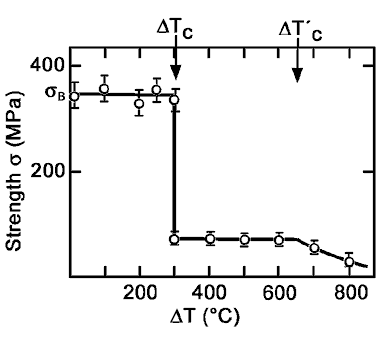5.4.3 Thermal
Shock Resistance
A large number of ceramic materials are
sensitive to thermal shock, which means that sudden changes
of temperature can lead to failure. Aluminium titanate, sintered
fused silica and materials based on cordierite are notable
exceptions.
The causes of this sensitivity to thermal shock are the internal
mechanical stresses induced by temperature gradients, and
the highly brittle nature of the ceramic material. Whereas
high local thermal stresses in metals merely lead to a slight
local plastic deformation, they can lead to the propagation
of cracks in ceramic materials. For this reason sudden, large
changes of temperature should be avoided whenever possible.
The thermal stresses responsible for the response to temperature
stress depend on:
- geometrical boundary conditions
- thermal boundary conditions
- physical parameters, such as
| |
coefficient of thermal expansion |
 |
| |
modulus of elasticity |
E |
| |
thermal conductivity |
 |
| |
strength |
 |
| |
and others. |
|
Determination of the sensitivity to thermal shock can be
carried out using a method suggested by Hasselmann. Test pieces
– in the simplest case these are bending bars –
are quenched to drop them from a temperature T0 to a temperature
Tu. The strength of the samples is measured after the quenching.
The curve of strength against the temperature difference,
 T
= T0 - Tu, has the shape shown on Figure 93. Up to a temperature
difference of T
= T0 - Tu, has the shape shown on Figure 93. Up to a temperature
difference of  Tc
the strength does not alter. The strength then drops sharply
within a narrow range, Tc
the strength does not alter. The strength then drops sharply
within a narrow range,  T.
Up to T.
Up to  Tc’
this reduced length then remains constant, falling away again
at higher temperature differences. Tc’
this reduced length then remains constant, falling away again
at higher temperature differences.

Figure 93: The strength of thermally shocked
bending samples according to Hasselman
Resistance to thermal shock or stress is
characterised in the literature by what are known as R parameters
(RS = resistance to thermal shock).

The values listed there for thermal shock
behaviour must only be looked on as general guidelines for
the various materials, because the individual physical and
mechanical data can vary widely. Other factors such as the
fracture toughness, KIC, and the specific thermal capacity,
Cp, also play a part.
Values obtained from homogenous ceramic material have only
limited relevance to the associated porous ceramics.
In practice, the geometry also plays an important part. For
this reason we have included a qualitative assessment in our
tables of materials.
Test procedures for determining the resistance to temperature
change are specified in DIN V ENV 820-3.
|

